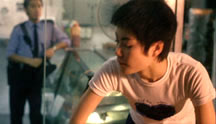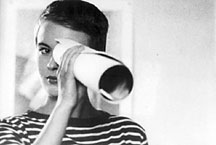JUMP CUT
A
REVIEW OF CONTEMPORARY MEDIA
![]()

Reflection in motion: these images of Faye Wong in 2046...


… and in Chungking Express gesture towards recurrent themes of identity, travel, movement and time.


Wong cannibalizes his own stylistic and thematic concerns in this music video for DJ Shadow…


…and in this commercial for Lacoste.

Chungking Express: intertextuality and identity

Cop 223 meets a mysterious woman in a bar…


… unaware that she is involved in the global drug trade…


…while Cop 663 is unaware that he is the object of Faye’s desire.


Travel motifs: toy aeroplanes are vehicles for a game of seduction played by Cop 663 and an air hostess…


…while the mysterious woman discovers at the airport that her drug couriers have disappeared.


Playing with the costumes and gestures of film noir.




… Faye shaking sauce bottles to the tune of California Dreaming…


… and Cop 663 acting out a scene with Garfield.


Faye writes out a “boarding pass” for 663. Is her uniform simply another costume?


The U.S. actress Jean Seberg sports a gamine hairstyle in Jean-Luc Godard’s Breathless…


… which is closely approximated by Faye’s. Both films play games of identity and difference with U.S. cultural signifiers.


Identity escapes: the mysterious woman is visible on screen for a fraction of a second, sans wig, yet we are still denied a clear view of her face.


Crossing paths: Faye and the mysterious woman amongst an array of pop-cultural referents.


Blurred images and rapid movements: a challenge to the colonial gaze, or an embrace of MTV aesthetics?
Trajectories of identification:
travel and global culture in
the
films of Wong Kar-wai
Hong Kong film director Wong Kar-wai has been embraced by the “West” in recent years, from his Best Director prize at the Cannes Film Festival in 1997, to the European co-financing of his films In the Mood for Love and 2046, to his commercials for Western corporations BMW and Lacoste and the music video he has directed for recording artist DJ Shadow. Wong also enjoys an enthusiastic reception in many Asian countries, with the conspicuous exception of Hong Kong itself. The popularity of his films abroad is parallelled in the films themselves by a tendency to draw upon “foreign” cultural referents: from film noir to Japanese fiction to Argentinian novels. In this environment, questions of cultural translation leap to the fore. What happens to the articulation of Hong Kong “identity” in these processes of intertextual appropriation and international reception?
In order to answer these questions, I have selected those Wong Kar-wai films which deal most specifically with cultural translation and travel: Chungking Express (1994), Happy Together (1997), In the Mood for Love (2000) and 2046 (2004). Arguably, Wong’s earlier film Days of Being Wild (1990) treads similar territory, as it incorporates transcultural references along with one character’s journey from Hong Kong to the Philippines to search for his mother. I am focussing on Wong’s more recent films, however, because they tackle the relationship between culture and travel in a more sustained and complex fashion. Each of the films discussed here charts different trajectories of identification, plotted along divergent axes defined in spatial and temporal terms. Overlaying this body of work is a broader trajectory pointing tentatively towards a qualified regionalism.
Amongst recent work on the director, Stephen Teo’s book-length study Wong Kar-wai stands out in its attempt to map the cinematic and literary references that inform the director’s work.[1] [open footnotes in new window] Yet whereas Teo seems most concerned with establishing the aesthetic value of Wong’s oeuvre, I would argue that more work remains to be done in showing how these films orchestrate their intertextual vectors in relation to the characters' global movements. In doing so, the films' narratives articulate the possibilities and the limits of transcultural identification. Furthermore, these films emerge within the context of Hong Kong’s 1997 handover to China, highlighting the territory’s status as both postcolonial and neocolonial. Against this backdrop, Wong Kar-wai’s films frame global culture and territorial identity in terms of travel, and bring into doubt critical approaches founded on straightforward notions of either cultural hegemony or resistance.
Chungking Express:
intertextuality and identity
Chungking Express blends the genres of romantic comedy and film noir in two adjacent tales. The first of these follows an undercover cop known as “Cop 223” (Takeshi Kaneshiro), whose girlfriend May has left him. Cop 223’s spiral of melancholy is interrupted when he spends a platonic evening with a mysterious woman (Brigitte Lin), who is, unbeknownst to him, a drug trafficker. The second tale follows another lovelorn cop, plainclothes officer #663 (Tony Leung Chiu-wai), who has a habit of talking to inanimate household objects. A regular customer at the Midnight Express takeaway bar, Cop 663 fails to notice that the cashier, Faye (Faye Wong), has fallen for him. He remains oblivious when she breaks into his apartment periodically, tidying and rearranging things. Finally he catches her in the act, and the two agree to a date at the California Bar. However, Faye departs for the “real” California instead, returning one year later to issue him a so-called “boarding pass” consisting of a paper napkin.
Chungking Express, like many of Wong Kar-wai’s films, emphasizes international travel. Characters are often leaving, have left or are about to leave for another country, and there is recurrent imagery of aeroplanes, passports, airports, toy jets and air hostesses. Alongside this “physical,” transnational movement is a parallel emphasis on “virtual,” transcultural mobility. The film actively plays with ideas of identity by investing itself with “foreign” cultural materials. These two parallel trajectories (the international and the intercultural) are closely linked, and can both be regarded within the context of identity formation.[2]
Despite its grounding in the context of mainstream Hong Kong cinema (in this case, the genres of action, romance and comedy), Chungking Express displays a variety of specifically foreign cultural references. The predominant tone of the film is informed by European and Japanese modernist “art” cinema. In particular, the breezy disregard for plot structure, the frequent musical interludes and the emphasis on style over psychology are reminiscent of the French New Wave films of Godard and Truffaut.[3] The piecemeal structure of the film reveals Wong’s affinity for South American writers, particularly Gabriel Garcia Marquez and Manuel Puig “(from whom, he says, he learnt to build a plot out of fragments).”[4]
Like the novels and short stories of Japanese writer Haruki Murakami, Chungking Express is peppered with pop culture references, and features ordinary folk in situations which are at once mundane and absurd. Cop 223’s obsession with pineapple cans is one example. Conversely, Curtis Tsui finds that Wong’s privileging of “emotionally expressive visuals” over “directly-stated narratives and characterizations” can be related to the Taoist art of mainland China.[5] Finally and most prominently, Chungking Express is indebted to the U.S. tradition of film noir. This influence is manifested in many ways: the unidentified woman’s raincoat and her femme fatale persona; the two cops with their deadpan voiceovers and confused perspectives; the drug-running plot; and the foregrounding of the urban setting. The relationship between Cop 663 and Faye, with its lightness of tone and series of missed connections, is also reminiscent of U.S. romantic comedies.
In fact, U.S. culture seems omnipresent in Chungking Express: the film is riddled with U.S. music, fashion and commercial products. For Gina Marchetti, this emphasis on commodification extends to the characters, to the point where they become commodities themselves. For example, Cop 223’s failed relationship with his girlfriend May becomes embodied in the cans of Del Monte pineapple which have passed their sell-by date. Similarly, the repetition of “California Dreamin’,” by the Mamas and the Papas, serves not only to highlight Faye’s desire to leave Hong Kong, but also to foreground the fact that the song is an item for consumption: mass-produced, identical each time it is played, and readily recognizable to a global audience. Accordingly, Marchetti argues that Chungking Express and other Hong Kong films show the way that: “American goods move beyond the market to construct the individual.”[6] This leads her to pose the following question: “Is the hybridity of Hong Kong just a new take on American cultural imperialism?”[7]
Although Marchetti is right to emphasize the importance of cultural encounters to the process of identity formation, I think that she is too quick to position these encounters solely along an Asian-U.S. axis. The multiplicity of cultures represented in the film weakens the case for a monolithic, unitary culture which overwhelms all others with its hegemonic power, acting as the “structuring principle for identity.”[8] As Arjun Appadurai points out,
“the United States is no longer the puppeteer of a world system of images, but is only one node of a complex transnational construction of imaginary landscapes.”[9]
Arguing against straightforward accounts of cultural homogenization, Appadurai states that
“at least as rapidly as forces from various metropolises are brought into new societies they tend to become indigenized in one or another way.”[10]
Chungking Express is arguably an exercise in indigenization. Dancing to “California Dreamin’,” Faye wipes cabinets, juggles bottles of tomato sauce, and serves customers. There is an element of performance in Faye’s behaviour, a sense in which she offers an interpretation of the song. A layer of comic irony accumulates with each repetition, as Faye’s routine and her mundane environment become more and more associated with the music. In this case, identity is not so much invested in the cultural object (the song), as it is created in the return journey conducted between the self and the object.
Indeed, the end of the film makes this metaphor literal, when Faye returns from the real California, stating that it is “nothing much.” Her journey has obviously changed her (she is now wearing the uniform of an air hostess), yet the changes have been complicated by her own interpretation of what she has seen and experienced. There also exists the possibility that Faye is not really an air hostess, and that her uniform is merely a costume she has acquired. In this reading, the costume would constitute a further extension of Faye’s performative behaviour. In any case, foreign cultural materials are appropriated by the other characters too: witness, for example, Cop 223’s idiosyncratic treatment of the Del Monte pineapple tins. Each character in his or her own way is investing these foreign objects with meanings that were never intended by their manufacturers.
Furthermore, Chungking Express, like Godard’s Breathless (1959), moves beyond indigenization and explores the limits of cultural identification. Not only do these two films pastiche the film noir genre, as Marchetti acknowledges[11] , they also work to disestablish its narrative mechanism. In Breathless, a young man (Jean-Paul Belmondo) with a penchant for imitating Humphrey Bogart steals a car, kills a policeman, and engages in a nonchalant affair with an U.S. woman (Jean Seberg), who later betrays him. The absence of a cohesive plot emphasizes the gap between the French characters and the Hollywood fantasies which they are aping, and a certain comic energy is generated in this way. In this sense, U.S. culture in Breathless is seen not only as a vehicle for identification but also as a stylistic accessory, something external — a definition of what the characters are not.
Similarly, Chungking Express cloaks itself in the paraphernalia of U.S. culture, but it is an investment in style rather than substance. This tendency is perhaps best exemplified by the mysterious woman (Brigitte Lin). Like Faye, she appears to define herself in terms of iconic American imagery, in this case a noir-ish raincoat, sunglasses and blonde wig (Gina Marchetti goes as far as to suggest a connection with Marilyn Monroe). Unlike Faye, however, the unidentified woman’s adoption of Western/ U.S. style cannot clearly be linked to her aspirations or desires. After killing her boss she throws the blonde wig aside, yet we are denied a clear view of her face. The raincoat, sunglasses and wig function as a disguise, a way to conceal identity rather than express it.
Amongst Wong Kar-wai’s professed influences are other precedents for this exploration of identificatory limits. In Haruki Murakami’s short story “The Second Bakery Attack” a newlywed couple are stricken with a hunger so unbearable that they take thirty hamburgers from a McDonald’s restaurant in an armed hold-up.[12] U.S. referents in the story (Big Macs, Coca Cola, The Wizard of Oz) are characterized simultaneously by a banal familiarity and an alienating distance. They oscillate between the local and the global, refusing to be either indigenous or foreign, creating a suspension of identification. In Manuel Puig’s novel, Kiss of the Spiderwoman, a queer prisoner in an Argentinian jail recounts the plots of old Hollywood movies to his activist cellmate.
In each case, comedy and pathos are generated by the incompleteness of the metamorphosis — by Belmondo’s failure to become Bogart, by the absurdity of Faye Wong’s exaggerated go-go dancing, and by the longing of Puig’s character for the distant world of old Hollywood movies. Thus, Chungking Express shows the limits of “American cultural imperialism”[13] and also betrays, in its very treatment of U.S. culture, the influence of other cultures (in this case, French and Argentine).
Whereas Marchetti emphasizes the way that consumer goods “construct the individual,” I would suggest that the foregrounding of consumer objects and surfaces (including the police and air hostess uniforms, as well as Brigitte Lin’s noirish disguise) points towards the impossibility of a full and complete representation of identity. The unidentified woman’s enigmatic exit is only the most obvious example. At the end of the film, the marking of Faye as a labour commodity (her air hostess uniform) parallels the masking of her intentions (will she stay with Cop 663?). We are given no insight as to why Faye might choose to leave the country rather than go on a date with Cop 663, the ostensible object of her desire. Similarly, Cop 663’s purchase of the Midnight Express takeaway bar is under-psychologized in “classical” narrative terms.
Moreover, the film’s overall privileging of colour, light and movement over clear, composed shots goes hand-in-hand with this rejection of character psychology. If, as Marchetti suggests, the film “self-reflexively recognizes itself as a commodity for exchange within the international art film market,”[14] then it also displays an awareness of the limited possibilities for manifesting identity in such objects, including itself. In this sense, the film itself is a fetish object par excellence. In this context, identity is not vested in foreign consumer objects. Rather, it is an elusive property that exists in the space between individuals, objects, and cultures, transforming and being transformed by them simultaneously. Chungking Express is notable for the way it foregrounds these negotiations, exploring the uneven territory where the local and the global meet.
In this sense, Chungking Express enacts what Ackbar Abbas has called a kind of “new localism.” Abbas deems new localism to be the most effective response to colonialism (of which globalism, he argues, is only the most recent manifestation). Other approaches have already lost their sting:
“a process of immunization has already set in against their power to provoke or to redefine institutional parameters.”[15]
Old-fashioned localism fails because of the difficulty of locating authenticity, marginalism because it cedes power to the colonial centre, and cosmopolitanism because it fails to account for difference.[16] Relying upon dislocation, impurity and hybridity, new localism succeeds where others have failed by exploring the disjunctive zones where the local and global intersect.[17] For Abbas, Wong Kar-wai’s films exemplify this new localism, and represent a kind of postcolonial resistance. The skewed perspectives, blurred images and fractured continuity in Wong’s films are, for Abbas, strategies for critiquing the colonial gaze, which depends upon stability, order and clarity in order to function. In addition, Abbas equates genre formulas with “colonization and self-colonization by clichés,” and finds in Wong’s manipulation of genre a destabilization of colonialism.[18]
Of course, in the case of Hong Kong, colonialism takes the form not only of British imperialism and U.S. cultural hegemony, but also China’s reclamation of the territory; the “postcolonial” resistance of Wong Kar-wai’s films must also function as resistance to the “neo-colonial.” Yet although Abbas’s notion of new localism is enlightening, his emphasis on resistance does not seem to fully account for the movements of identification taking place in the films. As I will be arguing, Wong’s films have an investment in narratives of modernity, an investment that serves to disrupt discourses of hybridity and resistance. This becomes particularly evident when examining later films such as Happy Together and In the Mood for Love.
To
top![]() Print
version
Print
version![]() JC 49
JC 49 ![]() Jump
Cut home
Jump
Cut home

This work is licensed under a Creative Commons Attribution-NonCommercial-NoDerivs 2.5 License.